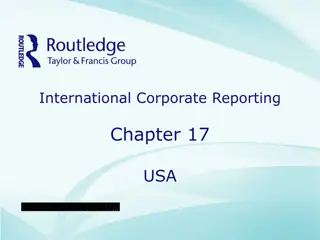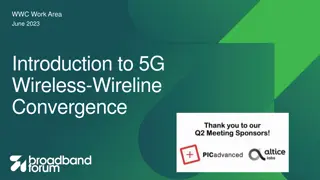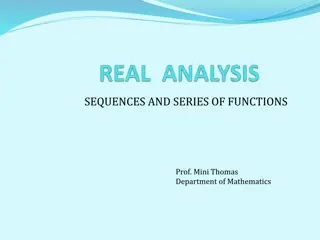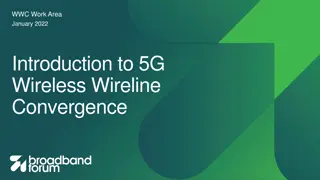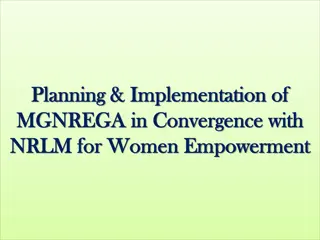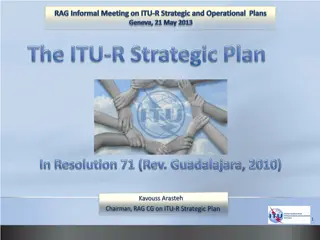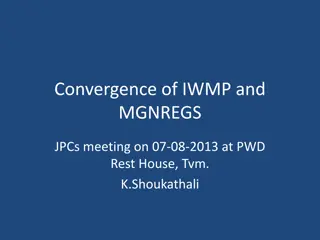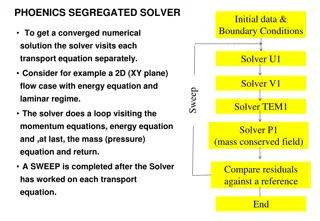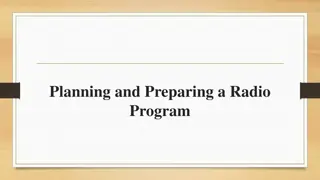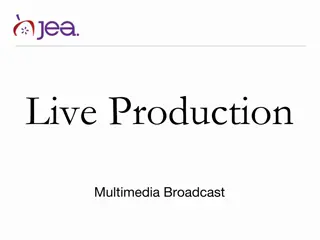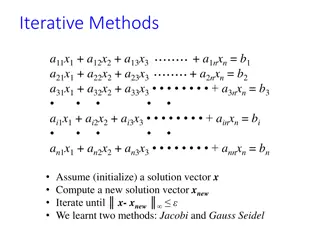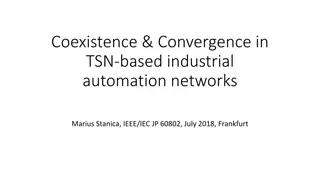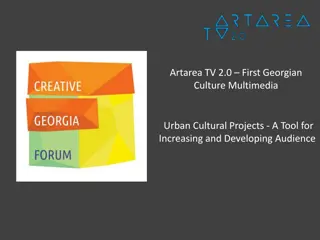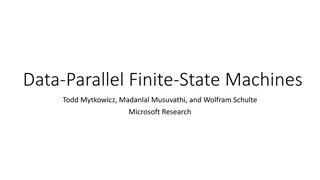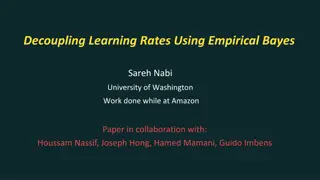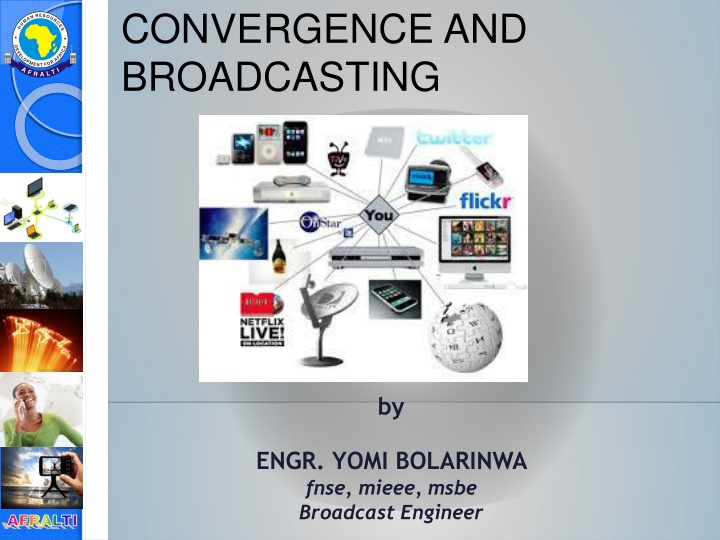
Digital Convergence in Broadcasting and Communication Technologies
Explore the concept of digital convergence in broadcasting and communication technologies, highlighting the importance of innovative work, technological advancement, spectrum sharing, and the evolution towards a digital nexus. Learn about the merging of technologies and the history behind the convergence of communication modes.
Download Presentation

Please find below an Image/Link to download the presentation.
The content on the website is provided AS IS for your information and personal use only. It may not be sold, licensed, or shared on other websites without obtaining consent from the author. If you encounter any issues during the download, it is possible that the publisher has removed the file from their server.
You are allowed to download the files provided on this website for personal or commercial use, subject to the condition that they are used lawfully. All files are the property of their respective owners.
The content on the website is provided AS IS for your information and personal use only. It may not be sold, licensed, or shared on other websites without obtaining consent from the author.
E N D
Presentation Transcript
CONVERGENCE AND BROADCASTING https://encrypted-tbn2.gstatic.com/images?q=tbn:ANd9GcRN23ZxkI5UVWpvkLaJbrLuwJqH9GEC9wyy_Pg8yYtGPzfCXhfh by ENGR. YOMI BOLARINWA fnse, mieee, msbe Broadcast Engineer AFRALTI
WHY CONCERGENCE? The need to increase spectrum availability has given rise to many innovative work, in terms of technological advancement, more efficient use of existing spectrum, infrastructure and spectrum sharing and the use of mixed wireless and wire line services. This led to DIGITISATION. Digitisation led to convergence AFRALTI
Digital Convergence in a technological revolution AFRALTI
The proposition that all modes of communication and information will converge into a digital nexus has been circulating for about twenty-five years. One of the earliest expressions of the idea came from Nicholas Negroponte, a technologist and founder of MIT's Media Lab. In 1978, he used three overlapping circles to represent the technologies of computing, printing, and broadcasting. The most rapid growth and innovation, he argued, could be found in the area where the three inter-sected. Negroponte had overlooked the telephone system, but simultaneously, telecommunications analysts were developing their own language of merging technologies. Harvard's. AFRALTI
Anthony Oettinger, coined the ugly neologism "compunications" to express the growing overlap of computing and telecommunications. French writers Nora and Minc independently came up with the more graceful "telematique" to express the same idea (Nora and Minc 1980). Neither term ever quite caught on, and to this day the world is still struggling with awkward combinations of terms such as "telecommunications," "information" and "computing" to label the basic technology of the information economy AFRALTI
SEARCHING FOR CONVERGENCE http://www.caneval.com/images/pictures/industryconvergence.jpg AFRALTI
CONVERGENCE Convergence is the merging of hitherto separate technologies such as computers with telephones, radio, fax machines and television or video AFRALTI
MEDIA CONVERGENCE In order for the media to converge, two main things need to occur: Computers and televisions must be able to be content interchangeable. People must be sufficiently interested in being able to view the same content on both devices to make implementation of this interoperability commercially viable. AFRALTI
MEDIA CONVERGENCE List of some of the content we might see on both the web and digital television in the future: Television Content: Television shows Movies Commercial Live Sports Game AFRALTI
MEDIA CONVERGENCE Internet Content: Media presentations Games Information blocks Live Sport Movies AFRALTI
THE TELEVISION WILL THE TELEVISION BE ABLE TO RECEIVE CONTENT? COMPUTER AFRALTI
Using a laptop, ipad or smart phone, while watching television AFRALTI
ADVANTAGES OF THE NEW IMPROVED SYSTEMS Advanced Commercials Movie Previews Channel News Channel Enhanced travelogue, home improvement and cooking shows. AFRALTI
DEVICE CONVERGENCE This means that the television in the living room will no longer be just a television, but information appliance. it will be an In addition to being able to display video streams, it will also be able to present other types of information-web pages, on-line stock quotes, interactive city maps, virtual lectures, etc. AFRALTI
THE SMART TV AFRALTI
THE SMART TV The Smart TV is a typical example of device convergence. It is also referred to as Connected TV or Hybrid TV A Smart TV is a TV that includes at least a rudimentary OS, access to web and Internet functions, and streaming content. They are like smartphones with application (app) support, which allow consumers to watch videos, browse the Internet, play games and do a lot more on a large screen. AFRALTI
SMART TV They capabilities Connected TVs are designed to provide a more immersive experience for television viewers by delivering interactive features such as Web browsing, social networking, video-on-demand and video streaming in addition to regular television content. are TVs with Internet-enabled AFRALTI
REGULATION Around the world the issues being thrown up by convergence and being debated upon is, what is the best regulating convergence? policy platform for AFRALTI
EVOLUTION OR REVOLUTION? The issue being debated is whether a new regulatory structure should be built on the back of existing laws and regulatory bodies, or whether entire infrastructures are required. new regulatory AFRALTI
REGULATION For many involved in the debates, caution appears to be the best way to handle what is clearly a transition period, if only on the grounds of providing precedent, especially as broadcasters begin entering the world of telecommunications and the telcos begin involving content. themselves in AFRALTI
EUROPEAN UNION Through the first half of 1998 it gathered opinions on a Green paper on Convergence issued in December 1997, which took as its starting point three options: Building current structures Developing a separate regulatory model for new activities, which telecommunication and broadcasting regulation. Progressively introducing a new regulatory model to cover all existing and new services. would coexist with AFRALTI
EUROPEAN UNION Among the general themes that arose from the submission preference for an evolutionary approach to change with the goal of creating a predictable regulatory framework that would encourage investment. Two areas of discussion came to the fore: Where should competition be applied and to what extent should it be balanced against sector specific rules What new regulations, if any, should be applied to on-line services, especially internet? was a strong AFRALTI
UNITED KINGDOM The UK is clearly opting for an evolutionary approach. While it acknowledges that convergence calls for new regulatory approaches, it believes that change is happening at a pace which can be handled through adapting existing regulatory bodies rather than starting again from scratch. AFRALTI
UNITED KINGDOM It does, however, have guidelines for handling change in its discussion of the issue, Regulating Communications: approach convergence in the Information Age issued by Department of Trade and industry, these are outlined as: Greater coherence in economic regulation across all digital delivery media Reassessment of the current regulatory distinctions based solely on the method of delivery to the consumer AFRALTI
Africa What can Africa learn from the discussions on the regulation of convergence taking place around the world? Should it be an Evolution or Revolution? Should regulations be built on the back of existing rules and bodies or is a totally new approach required? AFRALTI
ISSUES WITH CONVERGENCE 1 TVs are consumer level devices, which mean that they have to be cheap (for the average person). Being able to display the vast number of media types available today on the web (Macromedia, pdf, ps, RealAudio, RealVideo) will be expensive and challenging- you need a general purpose CPU ,RAM,OS etc. People will not be willing to pay, especially if they are not really going to use it. AFRALTI
ISSUES WITH CONVERGENCE 2 At this point in time, the TV and the WWW are fundamentally different TV is a broadcast medium, with virtually zero interactivity, while the WWW is a pull medium, with a high degree of user interactivity required. AFRALTI
ISSUES WITH CONVERGENCE 3 Another reason why it was assumed that WWW and TV content may not merge is the proliferation of handheld, portable, wireless devices that let you take the WWW (information + entertainment) wherever you are. AFRALTI
ISSUES WITH CONVERGENCE 4 Personal vs. public TV is an audience based thing many people can watch one movie together. On the other hand, interactivity in general, is personal. One person may have very different responses compared to another, making it difficult for more than one person to surf the web together for extended periods, or participate in an interactive program, unless specifically designed for multiple players. the WWW, and AFRALTI
ISSUES WITH CONVERGENCE 5 Indeed while telephone companies look at the issue of internet, especially web-casting or cybercasting with concern, broadcasters on their part are concerned about the idea of sharing screen estate with internet content. AFRALTI
ISSUES WITH CONVERGENCE 6 There is also the issue of content regulation which broadcasting is subjected to but which internet is not amenable to complying with. AFRALTI
ISSUES WITH CONVERGENCE 7 Some Global System for Mobile (GSM) companies have aspired to provide broadcast content on mobile services. This has raised arguments of a cell phone company indulging in broadcasting without a broadcast authorisation. In no distant future Recorders, DVPR s, would be conjointly available with mobile phones. A superior device, Digital Video Broadcast Hand held device DVBH, with phoning and internet capability is already available in the market. Digital Video Personal AFRALTI
CHALLENGES The challenge for the Regulator(s) is to work in harmony possibility of their licensees provide these value without any encumbrance of sectorial grandstanding. The onus to work out modalities to enable the people they serve take full advantage of modern services, lie collectively in the hands of government and the regulator(s). to facilitate the ability to services added convergent AFRALTI
CONCLUSION With the transition to Digital Terrestrial Transmission, the embracing broadcasting in a converged era cannot be overemphasized. importance of The Connected TV makes the broadcast viewing experience more engaging. We need to constantly leverage and stay in tune with the dynamism of Technology. Convergence will shape new policy and licensing regime. AFRALTI
Thank you for your attention! AFRALTI

